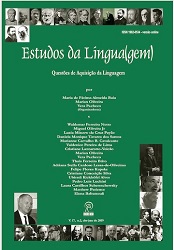Spanish intonation spoken by Brazilians: modeling with Bentatrainer2
DOI:
https://doi.org/10.22481/el.v17i2.5341Keywords:
Intonation modeling; Spanish as a Foreign Language; PENTATrainer2.Abstract
The aim of this study is to analyze the Spanish intonation spoken as a foreign language by Brazilians (SFL). To do so we analyzed three communicative functions that are transmitted by intonation, namely prominence, boundary and modality (declaratives, yes-no questions and wh-questions). We analyzed parallel production in two different speaking styles: reading isolated sentences and reading a text (narrative). We compared the data in SFL with same production of Spanish speakers. We analyzed the intonation with PENTATrainer2, an automatic tool that permitted to evaluate the power of synthesis of F0 contours in SFL and Spanish as a Mother Tongue, in both speaking styles studied. Results show that accuracy of the modeling is similar to what Barbosa (2016) has found for data in Brazilian Portuguese (BP) as compared to European Portuguese (EP).
Downloads
References
BARBOSA, P. A. Intonation modeling in cross-linguistic research. Benjamins, p. 115-134, 2016.
BOERSMA, P.; WEENINK D. 2009. Praat: doing phonetics by computer [Version 5.3.39] [Computer program]. Disponível em: <http://www.praat.org/> Acesso em: 20 mar. 2019.
CALVINO, I.; BARREIROS, J. C. Porque ler os clássicos. 2ª ed. São Paulo: Companhia das Letras, 1994.
JILKA, M. An introduction to intonation – functions and models. In: TROUVAIN, J.; GUT, U. (Ed.).Trends in Linguistics. Non-native prosody. Berlin: Walter de Gruyter, 2007, p. 77-96.
MARCO, C. S. Adaptaciones escolares de Don Quijote de la Mancha: criterios y modalidades. In: XL Congreso 400 años de Don Quijote: pasado y perspectivas de futuro, 2012, Valladolid. Proceedings... Valladolid, 2012. p. 197-209.
MENNEN, I. Phonological and phonetic influences in non-native intonation. In: TROUVAIN, J.; GUT, U. (Ed.).Trends in Linguistics. Non-native prosody. Berlin: Walter de Gruyter, 2007, p. 53-76.
MERLO, S. Dinâmica temporal de pausas e hesitações na fala semi-espontânea. 2012, 179p. Tese (Doutorado em Linguística) - Instituto de Estudos da Linguagem, Universidade Estadual de Campinas, Campinas, 2012.
PROM-ON, S.; XU, Y. THIPAKORN, B. Modeling tone and intonation in Mandarin and English as a process of target approximations. The Journal of the Acoustical Society of America. v. 125, n. 1, p. 405-424, 2009.
SILVA, C. C. Análise Fonético-experimental da entoação de declarativas e interrogativas em espanhol/LE. 2016, 225p. Tese (Doutorado em Linguística) - Instituto de Estudos da Linguagem, Universidade Estadual de Campinas, Campinas, 2016.
SILVA, C. C.; BARBOSA, P. The contribution of prosody to foreign accent: a study of Spanish as a foreign language. Loquens, v. 4, n. 2, p. 1-14, 2017.
TRIM, J. L. M. Some contrastive intonated features of British English and German. In: KLEGRAF, J.; NEHLS, D. (Eds.) Essays on the English language and applied linguistics on the accaion of Gerhard Nickel’s 60th Birthday. Heidelberg: Julius Groos, 1988, p. 235-249.
XU, Y.; WANG, Q. E. Pitch targets and their realization: Evidence from Mandarin Chinese. Speech Communication, v. 33, p. 319-337, 2001.
XU, Y. Speech melody as articulatorily implemented communicative functions. Speech Communication, v. 46, p. 220–251, 2005.
XU, Y.; Prom-on, S. Toward invariant functional representations of variable surfasse fundamental frequency contours: Synthesizing speech melody via model-based stochastic learning. Journal of Phonetics, v. 57, p. 181-208, 2014.
The R Project for Statistical Computing (version 3.5.2) [Computer program]. Disponível em: < http://www.r-project.org/>. Acesso em 20 mar. 2019.
Downloads
Published
How to Cite
Issue
Section
License

Estudos da Língua(gem) is licensed under a Creative Commons Attribution 4.0 International License.
Authors who publish in the journal Estudos da Língua (gem) agree with the following terms:
The journal Estudos de Língua(gem) maintains the copyrights of the contributions published. These rights include the publication of the contribution and make its content available for free through the portal.







